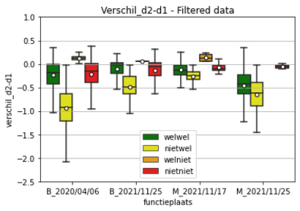
Port authorities are testing different maintenance methods for making port maintenance more efficient and sustainable. Within TKI project DEL 126 PRISMA II research is carried out for this purpose. PRISMA stands for Innovatief Sediment Management voor Havens". The aim is to reduce maintenance dredging costs and GHG emissions.
PRISMA II consists of different work packages:
Work package 1 : Water Injection Dredging (WID) monitoring and modelling
In this work package WID monitoring and modelling is carried out because WID can be a very efficient maintenance dredging method where forces of nature (gravity) are used to do the horizontal transport of sediment. In WID water is injected in the bed to fluidize the top layer of soil. This fluidized soil layer then starts to move as a near-bed density current and is steered by bathymetric slopes and (tidal) currents. WID works best for fine, cohesive soils. This type of soil can be difficult for other types of dredging equipment. WID can also be used to condition the mud to keep a port navigable without the need to take out all sediment.
In-situ monitoring of WID activities in the Calandkanaal area of the Port of Rotterdam (PoR) indicates that the increase of turbidity caused by WID remains close to the bed.

For modelling WID density currents rheological models are implemented in a 3D CFD (computational fluid dynamics) model TUDflow3D. With TUDflow3D the near-bed density current generated by a WID dredge can be simulated including the non-Newtonian flow aspect caused by the high concentration mud rheological behavior. The 3D CFD simulations can be used to optimize WID activities and to investigate where and how fast the near-bed WID density current will flow and where it will stop flowing.

Example of a non-Newtonian TUDflow3D 3D CFD simulation of a WID experiment
Additionally, the coupling tool (Cosumo) is extended to be able to couple a local near-field CFD model TUDflow3D to a far-field Delft3D model for WID density currents. With this coupling tool we are able to translate the near-field physics and WID density current characteristics from the CFD model in proper far-field source terms for Delft3D.
To enhance our system knowledge and to prepare for the future a quick scan into the possible influence of sea-level rise (SLR) on port sedimentation in Rotterdam is investigated. The scenarios with SLR show that 1m SLR as simulated schematically impacts the hydrodynamics, the dynamics of the salt wedge, the influence of wave-induced resuspension on the North Sea and subsequently the sedimentation in the port area noticeably. Especially for port basins near the location of the estuarine turbidity maximum at the end of the intrusion of the salt wedge the sedimentation is altered by SLR. Sedimentation in the Botlek (-14%) and Europoort (-22%) slightly decreases in the scenario with SLR, whereas sedimentation increases in the basins near the new location of the salt wedge (i.e. Pernis, Waalhaven, Fruithaven, approx.+15%).
Work package 2 : Large scale experiments in water-soil flume Deltares
Two large scale experiments are carried out within TKI PRISMA II:
For the STM experiment the water-soil flume (33m x 2.4m x 2.5m) of Deltares is filled with real PoR fluid mud of different dilutions and strengths. An object is pulled through this fluid mud at different speeds and the resistance force is measured. The measurements are used to validate the non-Newtonian flow behavior of a 3D CFD model for sailing through mud. With this knowledge and the CFD simulations sailing through mud it can be investigated how to apply sailing through mud in a safe manner. By applying sailing through mud maintenance dredging can be postponed or the mud could be conditioned instead of removed from a port. This could lead to a decrease in maintenance dredging greenhouse gas emissions and costs.


In the WID experiment the bottom 0.5m of the water-soil flume (33m x 2.4m x 2.5m) of Deltares is filled with undiluted bed mud from the PoR. The rest of the water-soil flume is filled with water. A jetbar mimicking a WID dredge is pulled over this bed injecting water via jets. The penetration depth is measured as well as the vertical density and velocity profile of the WID density current. Different WID tests are performed with different WID settings. It is the first time that WID experiments are performed at this big scale. With the experimental results WID processes can be optimized and understood better so that it can be applied more often and in a better fashion. As WID is a more efficient dredging method than most other dredging methods because it utilizes force from nature to perform the horizontal transport. Therefore, applying WID instead of regular dredging methods results in lower greenhouse gas emissions and costs.



Work package 3 : Data science for optimizing dredging
In the third work package data science is applied to already available in-situ datasets of dredging activities to optimize future dredging activities. The dredging trips are linked to the bathymetric survey before and after dredging and compared to the NGD (Nautical Guaranteed Depth). It is investigated how much of the trip dredging helped to comply with NGD and how much is preventive dredging where the depth already complied with NGD. Dredge trip data like the suction pipe density or difference in bathymetry before/after dredging are correlated to the classification of compliance with NGD, see for example the figure below. Dredging operations can be optimized.


Products
The following publications are available:
An overview report of TKI Prisma 2 is available here.